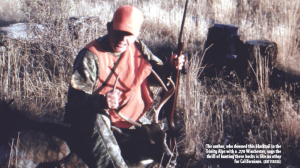Obsessing Over Blacktails
THREE AREAS AND TECHNIQUES FOR SCORING A BUCK
I only caught the quickest glimpse of the buck as he dashed across a narrow opening before disappearing down into a gully thick with oaks. A moment later I understood why. From in that leafy thicket came the ancient sound of two bucks locked in combat, the eerie clash of antlers, which sounded like two cue balls struck together hard and fast. It was stirring “bone music,” that even excited me. Suddenly, as fast as it all began, it fell strangely silent again.
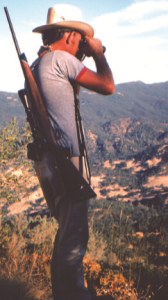 I was lying atop a weedy knoll in Northern California, where I had a good view of three deer trails that came up out of surrounding oaks meeting at a single ridgeline trail. As I waited to see what would happen next, I briefly glanced beyond the hills to the cold, dark waters of San Pablo Bay, which began to show a silver shimmer at the first rays of rising sunlight. Further out, I could even see
I was lying atop a weedy knoll in Northern California, where I had a good view of three deer trails that came up out of surrounding oaks meeting at a single ridgeline trail. As I waited to see what would happen next, I briefly glanced beyond the hills to the cold, dark waters of San Pablo Bay, which began to show a silver shimmer at the first rays of rising sunlight. Further out, I could even see
misty spires of tall buildings rising in San Francisco over 20 miles away.
The buck came up out of the thicket and stopped on the trail to look back down, ears forward, body taut, adrenaline still coursing through his veins, as if to say, “had enough? Learned your lesson?” He was satisfied he’d vanquished his foe and started down the trail in those little mincing steps blacktails always take as he delivered himself to me. At 40 yards, I began very slowly lifting my custom-made .270 Winchester loaded with 130-grain silver tips. When I snuggled in behind the scope I knew I could hardly miss.
This little tale is just one of the many methods and tactics I’ve used against the West’s most prolific big game animal, the widespread, antlered blacktail deer.
IT’S A WESTERN THING
When you say “the West,” most riflemen outside this region think only of mule deer; that is not the case. Blacktails have one of the longest north-to-south ranges – spanning 1,500 miles – of any big game animal on the planet. Beginning at the Mexican border they dominate the land throughout California, Oregon and Washington – from the Pacific Ocean inland over 200 miles – across the border into British Columbia and all the way north to Southeast Alaska, where their genus is called the Sitka blacktail. In the easternmost region of the three states below the border with Canada, mule deer only take over as the dominant species beyond the highest eastern peaks, where the land opens up and a high desert takes over. This dividing line can almost be drawn with a pencil on a map at that cover break because blacktails are cover deer that live out their lives in the thickest brush, tall timber or a mix of the two. Tens of thousands of Western sportsmen and -women rely on blacktails to make the term “deer hunting” a reality.
To hunt them successfully you must go into various types of cover and elevations to learn how to ambush them. The Golden State has all three types of cover in abundance. It’s an exciting and intriguing way to tag a set of antlers, if you learn your lessons properly. The easiest way to do this is to take these cover areas one by one and see what works for each. I’ve spent a lifetime doing so here. Here’s what’s worked for me:
BRUSHLANDS
In the lower elevations of California, rolling hills and low mountains are the rule and dominated by vast inland brush fields that seem to run on forever. Blacktails revel and prosper in it. Add to that the fact that deer season can open in early August when temperatures often run into the 90s and even triple digits, and you’ve really got your work cut out for you. It’s about as untraditional a way and time to hunt deer as is imaginable.
These bucks of summer are cagey, cautious, sneakers and peekers that know how to use cover to their best advantage. I’ve chased 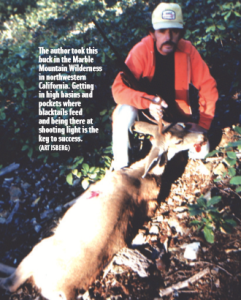 bucks around in manzanita, chemise and ironwood jungles without ever getting a glimpse of them, even though I could hear an animal moving as I did. They did not abandon cover and run for it as other big game would; instead, they stayed right in the jungles where they played their little game – and often won doing so. That’s what I call smart as well as bold thinking.
bucks around in manzanita, chemise and ironwood jungles without ever getting a glimpse of them, even though I could hear an animal moving as I did. They did not abandon cover and run for it as other big game would; instead, they stayed right in the jungles where they played their little game – and often won doing so. That’s what I call smart as well as bold thinking.
So how do you choose a place to hunt in this land that all looks so much the same? You do so by finding water of any size and getting above it. This can be anything from a bubbling puddle to a bathtub-sized spring. And when water is found in this land, it’s nearly always in lower basins, pockets and canyon bottoms in shady spots, under leafy pepper trees or down rocky gullies.
These deer will not only bed down nearby but also come in to drink at all hours of the day. I’ve watched them do this from the sit, when the worst heat of midday was sizzling hot, when you would naturally expect them to be down still in the cover of shade. The hotter it gets, the more likely deer will come to drink.
There are two productive ways to hunt these important hidden spots. One is for the lone hunter who has the patience to get comfortable in brushy shade above a wet spot and wait them out. When most other hunters are back in the shade of camp hydrating, you’re out on a stand biding your time for that magic moment when antlers suddenly show up.
One of the finest, heavy-antlered blacktail bucks I ever saw came in like this right at high noon. I sat motionless under a big manzanita bush barely 60 yards above. The sweat running down my face was not just because of the heat.
A second style of hunt requires you and one amigo. One gunner drops down into the canyon or pocket, moving slowly in a widening circle starting just at the top and going lower with each circle through cover. A partner on top moves with the other, keeping pace but staying high. From this topside one can see all that lies and moves below and can also look down into even thick cover because of the angle. If a buck is moved, whether the other hunter below sees it go out or not, the top hunter will get the shooting. This is a deadly hunt in thick brushlands.
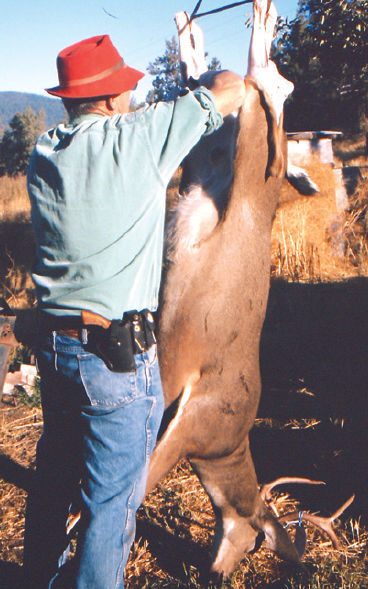 MOUNTAINS
MOUNTAINS
When I use the term “mountains” in the context of blacktail hunting, I’m talking about modest elevations that can also include foothills leading up to them. Throughout California this elevation can be between 2,500 and 3,500 feet. It’s also worth remembering this starts literally at the high tide mark of the Pacific Ocean.
Cover changes in this up-and-down land, from the smothering brush fields of interior valleys to taller, mixed cover such as spruce, ironwood, oaks and digger pines along rocky ridges. These changes dictate how you must hunt here. Because the land is a bit more open you have a real chance to catch deer out both early and late.
Blacktails that have fed all night move toward bedding grounds at sunup. My three hunting sons and I use what I call our two-hunt approach to match the deer’s natural timetable by extending the original hunt into a second one. We use this when taking on big canyons or sidehills, with the four of us spreading out on various high points along ridges. Of course, two or three rifles can certainly do the very same thing.
We position ourselves above deer trails, little basins and pockets where deer will go to bed down for the day, stay there until well after sunrise, watch and wait. If nothing shows up, the last rifleman – the one farthest down ridge – drops off the top heading downhill into the lower reaches of the canyon before starting back parallel toward the next stander. Reaching him, the second man moves down too, just above the lower hunter, both coming parallel toward the third rifle. No. 3 does the same thing slightly above the first two hunters, as all three work their way back toward the last rifleman on a canyon-wide sweep across cover areas to drive deer out. The last hunter can watch them moving toward him, plus additional animals they move out, with this three-man drive.
Bucks forced out like this often will try to climb out over the top, then drop down into another canyon or drainage and leave their pursuers behind. That last hunter is in the perfect spot to get a clear shot as they do so. The reason this tactic works so well is that even as smart as blacktails are, they are not two-dimensional thinkers. When fleeing hunting pressure, their only thought is to get away and leave trouble far behind as fast as possible; they don’t consider that another hunter is maybe waiting up ahead to ambush them.
These two hunts in one are a smart and productive way to thoroughly cover long sidehills and big canyons.
HIGH COUNTRY
I’ve said diversity is the rule in blacktail country, and this final area certainly illustrates that. Beyond brush fields and hill country rises true high country along the spine of coastal mountains in northwestern California into southern Oregon.
Here, rocky peaks that go up 5,000, 6,000 and 7,000 feet see heavy winter snows and the biggest bodies and antlered bucks of all. Record-book deer have been taken from this lofty land. It’s a land of dog-hair timber in forests that run endlessly up and down steep canyons blue in distance. But heavy forests provide only minimal feed for deer. They must climb into little greensward basins and open pockets just under the peaks where forage grows in abundance and they can fill their stomachs.
Rifle hunters want to climb early into these high pockets, getting just above them on the sit, and look for bucks still out feeding as dawn lights the high country. Here you are motionless; rising air cannot give away your scent, and moving bucks are easy to see in low cover.
These three pluses are what make this type of hunt so effective. If you do not find a set of antlers with this early schedule, the second tactic is to be down in timber on well-used deer trails coming off the tops. Look for recent tracks and fresh deer berries when choosing one.
As morning sun brightens timberland, deer will start down into cover, heading for places to rest and water for the day on these trails. You will be there waiting for them as they come on.
Two or three hunters can take as many trails, upping the odds someone is going to tag a set of antlers. Either of these two hunts are very productive because both rely on the blacktails’ natural timetable, and also because you are down and still not moving as you would using other methods. They are a favorite in the high country for my hunting family and me.
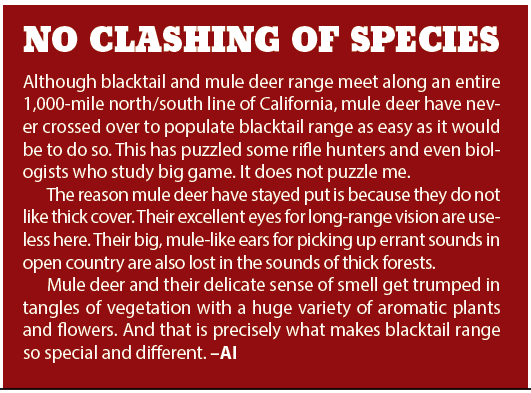
I’ve hunted these animals over a lifetime in all environments in this story. No other antlered big-game animal can give me a greater thrill than wrapping a tag around the rack of one of these smart and wary West Coast bucks. It’s deer hunting unlike any other on this continent. That’s what makes it so unique, fascinating and exciting. CS
By Art Isberg

